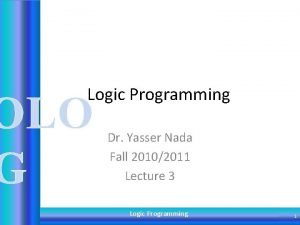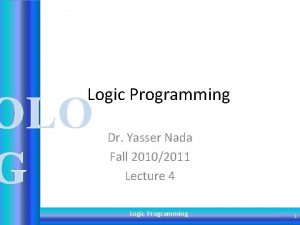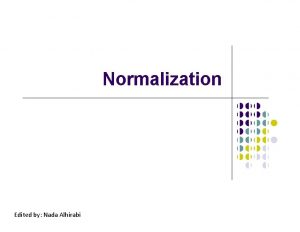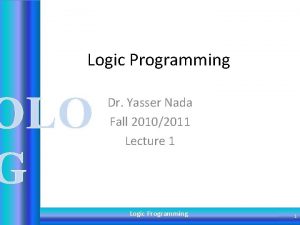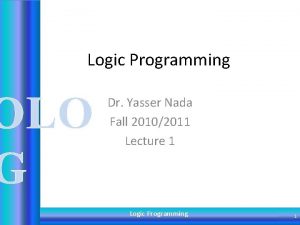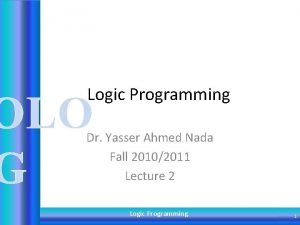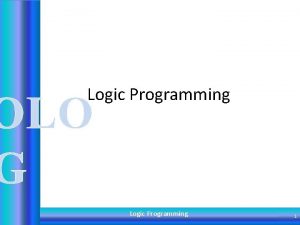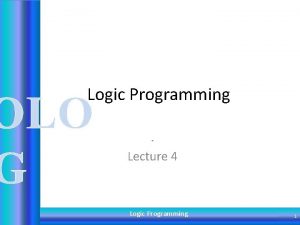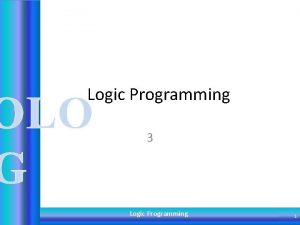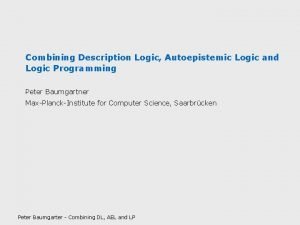Logic Programming OLO G Dr Yasser Nada Fall


![List • List also is represented as Head and Tail. – [H|T]=[a, b, c] List • List also is represented as Head and Tail. – [H|T]=[a, b, c]](https://slidetodoc.com/presentation_image/c1ea1fda97a0155e7beb2bfbc48146ec/image-3.jpg)
![List Construction • Assume X=[r, e, d]. • To add an element to the List Construction • Assume X=[r, e, d]. • To add an element to the](https://slidetodoc.com/presentation_image/c1ea1fda97a0155e7beb2bfbc48146ec/image-4.jpg)
![List Construction Example • If L = [b, c, d] then – M= [a List Construction Example • If L = [b, c, d] then – M= [a](https://slidetodoc.com/presentation_image/c1ea1fda97a0155e7beb2bfbc48146ec/image-5.jpg)
![List Deletion • Assume X=[r, e, d, c, o, l, o, r]. • To List Deletion • Assume X=[r, e, d, c, o, l, o, r]. • To](https://slidetodoc.com/presentation_image/c1ea1fda97a0155e7beb2bfbc48146ec/image-6.jpg)
![Unification • • [b, a, d] = [d, a, b] [X]=[b, a, d] [X|Y]=[he, Unification • • [b, a, d] = [d, a, b] [X]=[b, a, d] [X|Y]=[he,](https://slidetodoc.com/presentation_image/c1ea1fda97a0155e7beb2bfbc48146ec/image-7.jpg)

![print_list Example print_list([a, b, c]). H/a, T=[b, c] • print_list([]). write(a), write(‘ ‘), print_list([b, print_list Example print_list([a, b, c]). H/a, T=[b, c] • print_list([]). write(a), write(‘ ‘), print_list([b,](https://slidetodoc.com/presentation_image/c1ea1fda97a0155e7beb2bfbc48146ec/image-9.jpg)


![Member Predicate member(H, [H|T]). member(E, [H|T]) : - memebr(c, [a, b, c, d]). H/c, Member Predicate member(H, [H|T]). member(E, [H|T]) : - memebr(c, [a, b, c, d]). H/c,](https://slidetodoc.com/presentation_image/c1ea1fda97a0155e7beb2bfbc48146ec/image-12.jpg)





- Slides: 17

Logic Programming OLO G Dr. Yasser Nada Fall 2010/2011 Lecture 4 Logic Programming 1

List • List in Prolog is represented by square brackets with elements of the list is separated with a comma. OLO G – [] empty list. – [a] single element list. – [dog(fido), cat(rufus)] two element list. – [icecream, cofee, chocolate] three element list. • List can be nested: [1, [2, 3], a, b] has 4 elements. Logic Programming 2
![List List also is represented as Head and Tail HTa b c List • List also is represented as Head and Tail. – [H|T]=[a, b, c]](https://slidetodoc.com/presentation_image/c1ea1fda97a0155e7beb2bfbc48146ec/image-3.jpg)
List • List also is represented as Head and Tail. – [H|T]=[a, b, c] OLO G • H=a head of list. • T=[b, c] rest of list. • Head is the first element in the list. • Tail is a list of the original list excluding the first element from the list. Logic Programming 3
![List Construction Assume Xr e d To add an element to the List Construction • Assume X=[r, e, d]. • To add an element to the](https://slidetodoc.com/presentation_image/c1ea1fda97a0155e7beb2bfbc48146ec/image-4.jpg)
List Construction • Assume X=[r, e, d]. • To add an element to the head of the list X, we write: OLO G – Y=[b|X]=[b, r, e, d]. • To add three elements to the head of the list, we write: – Y=[a, b, c|X] = [a, b, c, r, e, d]. Logic Programming 4
![List Construction Example If L b c d then M a List Construction Example • If L = [b, c, d] then – M= [a](https://slidetodoc.com/presentation_image/c1ea1fda97a0155e7beb2bfbc48146ec/image-5.jpg)
List Construction Example • If L = [b, c, d] then – M= [a | L] = [a, b, c, d] • If L = [b, c, d] then – N = [[a] | L] = [[a], b, c, d] • If L = [[b], c, d] then – K = [a | L] = [a, [b], c, d] Logic Programming 5
![List Deletion Assume Xr e d c o l o r To List Deletion • Assume X=[r, e, d, c, o, l, o, r]. • To](https://slidetodoc.com/presentation_image/c1ea1fda97a0155e7beb2bfbc48146ec/image-6.jpg)
List Deletion • Assume X=[r, e, d, c, o, l, o, r]. • To delete the first three element from the list X, we write: OLO G – X=[A, B, C|T] A=r, B=e, C=d, T=[c, o, l, o, r]. • If we delete the first element from an empty list, then fail is returned. – If Y=[], then if we write: • Y=[A|T] this returns fail. Logic Programming 6
![Unification b a d d a b Xb a d XYhe Unification • • [b, a, d] = [d, a, b] [X]=[b, a, d] [X|Y]=[he,](https://slidetodoc.com/presentation_image/c1ea1fda97a0155e7beb2bfbc48146ec/image-7.jpg)
Unification • • [b, a, d] = [d, a, b] [X]=[b, a, d] [X|Y]=[he, is, a, cat] [X, Y|Z]=[a, b, c, d] [X|Y]=[[a, [b, c]], d] [X|Y]=[a] OLO G fail to match. fail. X=he Y=[is, a, cat] X=a Y=b Z=[c, d] fail X=[a, [b, c]] Y=[d] X=a Y[] Logic Programming 7

Write/1 predicate • Write/1 predicate is a predicate that accepts one argument and write it out on the output device (screen or file or printer). OLO G • Write/1 predicate always return true, if the argument is a legal term. • To write all elements of a list we write: – print_list([]). – print_list([H|T]) : - write(H), write(‘ ‘), print_list(T). Logic Programming 8
![printlist Example printlista b c Ha Tb c printlist writea write printlistb print_list Example print_list([a, b, c]). H/a, T=[b, c] • print_list([]). write(a), write(‘ ‘), print_list([b,](https://slidetodoc.com/presentation_image/c1ea1fda97a0155e7beb2bfbc48146ec/image-9.jpg)
print_list Example print_list([a, b, c]). H/a, T=[b, c] • print_list([]). write(a), write(‘ ‘), print_list([b, c]). • print_list([H|T]) : write(H), write(‘ ‘), print_list(T). OLO G • ? print_list([a, b, c]). • abc print_list([b, c]) H/b, T=[c] write(b), write(‘ ‘), print_list([c]), H=c, T=[] write(c), write(‘ ‘), print_list([]). [] [H|T] Logic Programming 9

Typical Pattern of Prolog Programs • It is very important to understand the print_list example, because it is a typical pattern of how prolog programs are written: OLO G – Base case. – Inductive case. • Example: Write a prolog program to check if two lists has the same length (same no. of elements). same_length([], []). same_length([H|T], [H 1|T 1]) : same_length(T, T 1). ? same_length([a, b], [c, d]). yes ? same_length([a, b], [c]). no Logic Programming 10

More Examples on Lists • Ex. 4. 3 -part 1: Write a prolog program to print every other element of a list. prt. Second([H|T]) : - prt_2([H|T], 0). OLO G prt_2([], _). prt_2([H|T], 0) : - prt_2(T, 1). prt_2([H|T], 1) : write(H), write(‘ ‘), prt_2(T, 0). Logic Programming ? prt. Second([]). no ? prt. Second([a]). yes ? prt. Second([a, b]). b ? prt. Second([a, b, c, d] bd 11
![Member Predicate memberH HT memberE HT memebrc a b c d Hc Member Predicate member(H, [H|T]). member(E, [H|T]) : - memebr(c, [a, b, c, d]). H/c,](https://slidetodoc.com/presentation_image/c1ea1fda97a0155e7beb2bfbc48146ec/image-12.jpg)
Member Predicate member(H, [H|T]). member(E, [H|T]) : - memebr(c, [a, b, c, d]). H/c, [H|T]=[a, b, c, d] E = H, member(E, T). OLO G E/c, [H|T]=[a, b, c, d] c=a, member(c, [b, c, d]). H=a, [H|T]=[b, c, d] E=c, [H|T]=[b, c, d] c=b, member(c, [c, d]). H=c, [H|T]=[c, b] c=c , member(c, [d]). Logic Programming 12

Example Write a Prolog program to add an element to the end of a list. addend(E, [], [E]). addend(E, [H|T], [H|T 1]) : addend(E, T, T 1). OLO G ? addend(c, [a, b], L). L = [a, b, c]. ? addend(c, [a, b], L). E=c, []=[a, b] E/c, [H|T]=[a, b], L=[a|T 1] addend(c, [b], T 1). E=c, []=[b] E=c, [H|T]=[b], L/[b|T 1] addend(c, [], T 1) E=c, []=[], T 1=[c] Logic Programming 13

List Example • Ex 4. 3 -part 5: Write a prolog program that takes a list as its first argument and return a list of vowels as the second argument OLO G vowel_list([a, e, o, I, u]). vowel_letter(C) : - vowel_list(L), member(C, L). member(H, [H|T]). member(E, [H|T]) : - E=H, member(E, T). vowels([], []). vowels([H|T], [H|T 1]) : - vowel_letter(H), vowles(T, T 1). vowels([H|T], L) : - not(vowel_letter(H)), vowels(T, L). Logic Programming 14

Testing the Last Example ? vowels([p, r, o, l, o, g, p, r, o, g, r, a, m, m, i, n, g], L). L=[o, o, o, a, i] ? vowels([c, r, y, p, t], L). L=[] OLO G Logic Programming 15

Homework • Ex. 4. 2, 4. 3 -part 2, 3, 4, 6. OLO G Logic Programming 16

Questions OLO Logic Programming 17
 Nada enharmonis dari bb adalah
Nada enharmonis dari bb adalah 2322008
2322008 Francis yasser
Francis yasser Define olo
Define olo Programme olo inscription
Programme olo inscription Precious blood apostolate olo-nigeria
Precious blood apostolate olo-nigeria Olo g
Olo g Estamos aqui de passagem nada trouxemos e nada levaremos
Estamos aqui de passagem nada trouxemos e nada levaremos Nada te turbe; nada te espante salmo 37
Nada te turbe; nada te espante salmo 37 Quien es nada
Quien es nada Nada te turbe santa teresa
Nada te turbe santa teresa Nada te turbe analisis
Nada te turbe analisis Salmo 37, 7 nada te turbe
Salmo 37, 7 nada te turbe Tudo para o estado nada contra o estado nada fora do estado
Tudo para o estado nada contra o estado nada fora do estado Nada des enharmonis dengan nada.
Nada des enharmonis dengan nada. Nada te turbe taize letra
Nada te turbe taize letra If x = 0 and y = 1, which output line is enabled?
If x = 0 and y = 1, which output line is enabled? First order logic vs propositional logic
First order logic vs propositional logic



